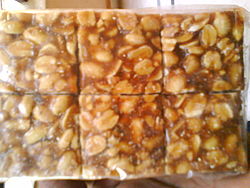- Chikki
-
Chikki 
Chikki packOrigin Place of origin India Region or state Maharashtra Dish details Course served Snack Main ingredient(s) Groundnut, jaggery Chikki is a traditional ready-to-eat Indian sweet generally made from groundnuts and jaggery.[1] There are several different varieties of chikki in addition to the most common groundnut chikki. Each chikki is named depending upon the ingredients used. Usually, ingredients such as puffed/roasted bengal gram, sesame, puffed rice, beaten rice, and Khobara(desiccated coconut) are used.
It is also extremely popular in Brazil, where it is known as pé-de-moleque (boy's foot).
Contents
Types
Some chikkis are made using a combination of these ingredients. Special chikkis are made out of cashews, almonds, and pistachios.
Though jaggery is the usual sweetener material, sugar is used as the base in certain types of chikkis. It is a very popular sweet item in both rural and urban Indian subcontinent (spanning India, Pakistan, Bangladesh, Nepal and Sri Lanka). Some people also add glucose to the chikkis, and "glucose chikkis" are very famous in the Indian subcontinent.
Preparation
The preparation of chikkis is very simple and consists of first preparing the hot jaggery syrup with a minimum of water, adding nuts to the syrup to coat them (with the syrup) and then transferring the nuts to a wooden mould, then rolling them to a thickness of about 6–8 mm using a wooden roller, cutting into slabs, and packing. In homes, smaller quantities are hand rolled with wooden rollers.
Most popular chikkis are sourced from India's Lonavala, Matheran and Karjat near Mumbai.[2]
Pé-de-moleque
Pé-de-moleque ("urchin foot") is a traditional sweet from the Brazilian cuisine made of peanuts and jaggery or molasses. The origin of name lies in the fact that most streets in colonial Brazil were made by laying down various odd rocks in a loose layer of sand/dirt, and having street-boys stomp on them to flatten the surface. Streets made by this method came to be called "pé-de-moleque." The appearance of the peanuts stuck together by molasses was found to be similar to that of these types of streets, and so, the sweet took the same name.
The candy is prepared by mixing roasted, peeled peanuts with melted brown sugar or rapadura, with or without the addition of macerated peanuts as well. The mixture is gently stirred over low heat until it gets close to crystallizing. Then the mixture is placed on a plain stone or metal surface (preferably thinly oiled with butter to ease removal) in pieces similar in size to cookies. This traditional preparation results in soft, irregularly-shaped sweets of a dark brown colour. Softness results from the incorporation of peanut oil.
Besides the traditional process, the sweet is also produced industrially, by mixing melted sugar with peanuts and then pouring the mix into square moulds, resulting in hard bars of a lighter colour.
References
External links
Categories:- Brazilian desserts
- Confectionery
- Indian desserts
- Culture of Maharashtra
- Lonavala-Khandala
Wikimedia Foundation. 2010.


